Liquids, or mixtures of liquids, or liquids containing solids in solution or suspension which gives off a flammable vapour at or below 60°C closed-cup test is classified as flammable liquid in transport regulations. Flashpoint is the lowest temperature of the liquid at which its vapour forms an ignitable mixture with air.
GHS & Transport Regulations Classifies flammable liquid under below Categories

Packing group assist the shipper to select the right package.
Certain flammable liquid which are viscous, such as paints, enamels, varnishes, adhesives and polishes, having a flashpoint of less than 23°C may be placed in packing group III provided it meets the conditions laid down in part III, chapter 32.3, of the United Nations Manual of Tests and Criteria, which includes:
- the viscosity, expressed as the flowtime in seconds
- the closed-cup flashpoint
- a solvent separation test, and
- the capacity of the receptacle used does not exceed 30 ℓ and no additional risk of corrosivity or toxicity
Flammable liquid which has flashpoint of more than 35°C may be exempted from provisions of IMDG Code if it does not sustain combustion. The criteria for a liquid to be not sustaining combustion is if;
- they have passed the suitable combustibility test (see the Sustained Combustibility Test prescribed in part III, 32.5.2 of the United Nations Manual of Tests and Criteria); or
- their fire point according to ISO 2592:1973 is greater than 100°C; or
- they are water-miscible solutions with a water content of more than 90%, by mass.
Flammable Liquid also includes
- liquids offered for transport at temperatures at or above their flashpoint;
Example: Benzoic Acid Molten has a flashpoint of 121 Deg C and its melting point is 122 Deg C, When transported as Molten the cargo temperature is greater than 122 Deg C which is higher than its flashpoint.
2. substances transported or offered for transport at elevated temperatures in a liquid state, which give off a flammable vapour at temperatures equal to or below the maximum transport temperature.
Example: Bitumen
While filling flammable liquid into packages the filler must ensure to take measures to prevent dangerous electrostatic discharge and must strictly adhere to the degree of filling for tanks.
Flammable liquid may have additional risk of toxicity or corrrosivity. For those liquids, having multiple hazards and are not listed by name in IMDG Code the shipper must classify them according to part 2.0 & 2.3 of the Code taking great attention to precedence of hazards, Classification of substances, mixtures and solutions with multiple hazards.
Class 3 also includes liquid desensitized explosives which are explosive substances dissolved or suspended in water or other liquid substances, to form a homogeneous liquid mixture to suppress their explosive properties. Follwing are the entries in IMDG Code for liquid desentisized explosives:
- UN No. 1204 NITROGLYCERIN SOLUTION IN ALCOHOL with not more than 1% nitroglycerin
- UN No. 2059 NITROCELLULOSE SOLUTION, FLAMMABLE with not more than 12.6% nitrogen, by dry mass, and not more than 55% nitrocellulose
- UN No. 3064 NITROGLYCERIN SOLUTION IN ALCOHOL with more than 1% but not more than 5% nitroglycerin
- UN No. 3343 NITROGLYCERIN MIXTURE, DESENSITIZED, LIQUID, FLAMMABLE, N.O.S. with not more than 30% nitroglycerin, by mass
- UN No. 3357 NITROGLYCERIN MIXTURE, DESENSITIZED, LIQUID, N.O.S. with not more than 30% nitroglycerin, by mass
- UN No. 3379 DESENSITIZED EXPLOSIVE, LIQUID, N.O.S.
Emergency Response on board ships
For carriage on board ships flammable liquids are permited to be loaded on or under deck as per the stowage category assigned in IMDG Code for a particular UN Number with the assigned packing group and as per Document of compliance for ships carrying dangerous goods under the provisions of regulation II-2/19 of the 1974 SOLAS Convention, as amended.
In Document of Compliance permitted stowage in under deck spaces are separately listed for
Class 3 Flashpoint < 23°C
Class 3 Flashpoint ≥ 23°C to ≤ 60°C
Class 6.1 liquids Flashpoint < 23°C
Class 6.1 liquids Flashpoint ≥ 23°C to ≤ 60°C
Class 8 liquids Flashpoint < 23°C
Class 8 liquids Flashpoint ≥ 23°C to ≤ 60°C
Certain flammable liquids will float on water and if firefighting personnel direct the water jet on to the liquid it may result in spreading of fire further creating greater danger. During fire heated flammable liquid will release vapours which will burn with explosive effect. Firefighting personnel must stay in well protected area and use water spray to cool down the temperature of the liquid and vapour.
Vaporized flammable liquid may result in devastating Vapour Cloud Explosion. Some of the flammable liquids are corrosive to skin or to ships hull. Long term toxic effects are not classified and labelled hence ships personnel must take great care while dealing with spillage or fire involving flammable liquid. It is highly recommended to use self-contained breathing apparatus while dealing with flammable liquid incidents and accidents on board vessel.
General Comments for fighting fire of Non-Water Reactive Flammable Liquids:
- Cargoes in tanks exposed to heat may explode suddenly in or after a fire situation by a Boiling Liquid-Expanding Vapour Explosion (BLEVE).
- Keep tanks cool with copious quantities of water.
- Fight fire from a protected position from as far away as possible.
- Stop leakage or close open valve if practicable.
- Flames may be invisible.
Container fire on deck: Cool burning transport units and nearby cargo exposed to the fire with copious quantities of water.
Container fire under deck: Stop ventilation and close hatches. Use cargo space fixed fire-extinguishing system. If this is not available, create water spray using copious quantities of water.








